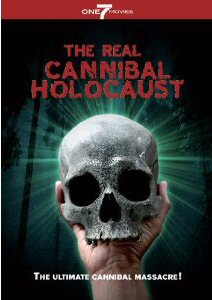
(A.k.a. NUOVA GUINEA, L’ISOLA DEI CANNIBALI; GUINEA AMA)
The onscreen title is NUOVA GUINEA, ISOLA DEI CANNIBALI.
An earnest Italian voiceover offers a rudimentary geography lesson as the camera provides an aerial view of Papua New Guinea’s luscious jungles.
As the shots become more localised and begin to focus on Papua’s natives going about their daily toil – running half-naked through greenery; communal canoeing – the narrator tells of how Papua won its independence from Australia in 1973 (a year before this film was made).
Then were transported to Goroka, "the heart of Eastern New Guinea", where the locals are anticipating a visit from Queen Elizabeth the 2nd. She wants to see how they’re coping with their newfound independence. Cue insultingly threatening music as the natives race to their airport to greet her. Some of them, from the Maracawa tribe, have travelled on foot for four days just to be there.
When the Queen arrives (yes, the actual Queen is included in the footage) we’re told the onlookers are disappointed that she does not wear feathers or animal bones to distinguish herself from any other white woman. "She too is perplexed", the narrator claims.
As if to answer Her Majesty’s unspoken pleas, the film then delves deeper into the lifestyles of these native tribes. Without hesitation, it takes us straight into the startling sight of an aged woman feeding off the maggot-infested remains of her late husband. "It is a form of love beyond death", we’re told.
Next up we’re treated to candid handheld shots which explore local funerals, complete with exposed remains laid bare for all to see. Elsewhere, another tribe "smoke" the corpse of a recently deceased friend. This sequence is lengthy and certainly looks to be authentic, whereas some of the stuff that crops up during the film is rather suspect.
The documentary continues, taking us further into the jungle villages inhabited by these often colourful natives. We get to see ritualistic dancing, more saggy triangular breasts (male and female) than you could shake a stick at, and – of course – an assortment of documentary evidence to support the commentator’s serious insistence that theirs is a society that thrives on violence.
In-between, lighter moments (I use the term very liberally) include the native’s own takes on make-up and tattooing, and a few observations on their outlandish sexual practices.
The real reason for this film’s being though, is surely to capitalise on the then-popular mondo genre: this Italian-Japanese co-production clearly aims to exploit the ignorant audiences of the early 70s, who could be duped into swallowing yet another ‘expose’ on how life plays out in one of the world’s most remote destinations.
As a result, the trappings of the genre are correct and present: the aforementioned local nudity gets in there early and keeps reappearing throughout. No shockumentary would be complete without scenes of genuine animal cruelty and this one is no exception (care to watch bats being skinned, or several pigs getting their skulls bludgeoned with wooden stumps, anyone?). Bodily mutilations (of the voluntary kind), bizarre medical practices and scarification are also thrown in for good measure.
Indeed, the film is grim on frequent occasions. Practically the only atrocity it doesn’t revel in is actual cannibalism. When it is mentioned, we get to see the aftermath of the action. After all, as the narrator explains, cannibalism may come natural to these folk ... but is illegal even within their world.
It’s a fairly unrelenting affair, absurdly set to upbeat pop songs for the most part. Most scenes are shot in flat documentary style by director Akira Ide, although occasional moments – such as the camera following the police arrest of a suspected cannibal – employ canny editing, pans and piano-heavy tension to attempt something more cinematic.
Finished off in quite a proficient manner, THE REAL CANNIBAL HOLOCAUST is actually one of the better mondo movies in recent memory. But it’s still a mondo film, and they either appeal or they don’t.
Just ignore the title: this has absolutely nothing to do with Ruggero Deodato’s CANNIBAL HOLOCAUST, other than featuring musical contributions from Riz Ortolani.
The film is presented uncut in 1.33:1. Images are slightly faded and the footage used not only suffers from grain, but also scratches and occasional lines. The aspect ratio appears to be correct and whatever damage the film exhibits doesn’t harm its grindhouse aesthetics. The transfer itself appears to be fine, with nothing in the way of unstable blacks or unsightly edge enhancement.
Italian mono 2.0 audio is decent throughout, offering a fairly clean playback. Optional English subtitles are easy to read and mainly free from typing errors.
One 7 Movies’ DVD is region-free and opens with a colourful static main menu page that echoes the cover art. An animated scene-selection menu allows access to the film via 12 chapters.
There are no extras.
One 7 Movies should be commended for affording THE REAL CANNIBAL HOLOCAUST with a legit DVD release. But that doesn’t alter the fact that the film itself is rather specialised fare. Past its misleading title, it offers little for all but the most die-hard of mondo fans. And the animal scenes are nauseating.
Review by Stuart Willis
| Released by One 7 Movies |
| Region 1 - NTSC |
| Not Rated |
| Extras : |
| see main review |